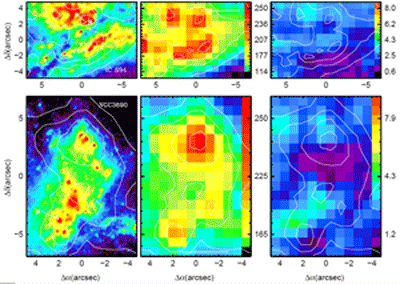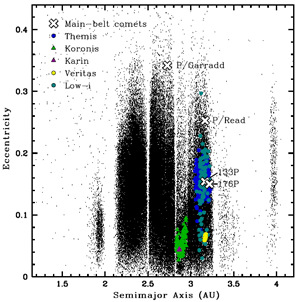Highlights - Volume 505-3 (October III 2009)
- Details
- Published on 08 October 2009
| HIGHLIGHTS: this week in A&A |
Volume 505-3 (October III 2009)
| In section 4. Extragalactic astronomy “Integral field optical spectroscopy of a representative sample of ULIRGs. II. Two-dimensional kpc-scale extinction structure”, by G-M Garcia-Marin, L. Colina, and S. Arribas, A&A 505, p. 1017 Merging galaxies are sometimes huge dusty starbursts, emitting mostly in the infrared and called ultraluminous infrared galaxies (ULIRGs). A sample of local ULIRGs has been studied through maps of H-alpha/H-beta line ratio to derive extinction effects. It is found that the IR-based star formation rate is always higher than the optically based one, by factors of 2 to 30. The optical (I-band) half-light radius is on average a factor 2.3 more than the near-IR (H-band) value. This implies that dynamical masses in ULIRGs and their high-z analogs could be overestimated by a factor of at least 2.3. |
|
| In section 10. Planets and planetary systems “The Hawaii trails project: comet-hunting in the main asteroid belt”, by H. H. Hsieh, A&A 505, p. 1297 Hseih hunts for comets in the main asteroid belt. His article in this issue describes the Hawaii trails project, which has so far observed 599 asteroids and led to the discovery of the class of main-belt comets. The present results of the survey suggest that there could be about 100 currently active main-belt comets among low-inclination, kilometer-scale outer belt asteroids. |
|
| In section 2. Astrophysical processes “A decade of SN1993J: discovery of radio wavelength effects in the expansion rate”, by J.M. Marcaide, I. Marti-Vidal, A. Alberdi, et al., A&A 505, p. 927 The early phases of the expansion of a supernova, when the ejecta interact with circumstellar material, is a subject of great current interest both in its own right and because of possible cosmological applications. The study of Marcaide et al. highlighted here summarizes a decade of VLBI observations of the supernova 1993J in the nearby galaxt M81 where precision measurements of the variation in radius with time have been possible. These show slight but significant differences between the behavior at 6 and 18 cm, suggesting that opacity effects are influencing the results. |
| In section 3. Cosmology (including clusters of galaxies) “Constraints on leptonically annihilating dark matter from reionization and extragalactic gamma background”, by G. Hütsi, A. Hektor, and M. Raidal, A&A 505, p. 999 It is nowadays clear that the majority of the matter contained in the Universe differs considerably from the normal matter ("baryons") out of which stars, planets and ourselves are born. However, we have only vague ideas about the nature of the particles constituting this elusive dark matter (DM), whose effects can be measured through gravitational experiments. More recently, a set of high-energy experiments has detected an excess of positron flux in the Galaxy, which possibly exceeds the expected background produced by known astrophysical sources. Astroparticle physicists have then put forward the idea that this excess could be produced if DM particles are not stable but rather decay or annihilate, thus cascading in a plethora of particles among which high-energy, ionizing photons and positrons possibly responsible for the excess. The authors in this paper use the available measurements of the gamma-ray background and electron scattering optical depth to constrain the mass and annihilation channels of DM particles, thus intriguingly bridging cosmic phenomena and particle physics. |
You can now receive the A&A weekly Highlights by email. To subscribe to the A&A Highlights emailing list, please send an email to This email address is being protected from spambots. You need JavaScript enabled to view it.
© Astronomy & Astrophysics 2009



